Bilateral Keratoconus: An Interesting Use of an EyeBrid AirKone Hybrid Lens with Tangible Hydra-PEG Coating
by Dimitri Guimond, MSc in Optical Sciences and Optometry
The patient is a 25-year-old male supermarket worker and a keen sportsman (football). He consults his ophthalmologist every two years at his city-centre location. He has reduced visual acuity that cannot be improved with glasses. He has no particular medical-surgical history. He was referred to a University Hospital Centre (CHU) specialising in the management of keratoconus. After multiple examinations, he was referred by his specialist physician to a contact lens fitting centre for a first-time contact lens fit.
Clinical Presentation
During the eye test, the best-corrected visual acuity (BCVA) with glasses was measured at 20/200 OD and 20/20- OS.
Examination of the anterior segments on the slit lamp revealed:
· A tear film with few inclusions, regular tear flow
· Grade 1.5 bulbar and palpebral conjunctival injection on the Efron scale
· Grade 1.5 eyelid roughness on the Efron scale
· Corneal thinning more pronounced on the apex OD with the presence of Vogt’s striae.
· OS presents some thinning and no Vogt’s striae visible with the slit lamp.
The corneal topography below highlights the different stages of the evolution of the keratoconus, its morphology and its location.
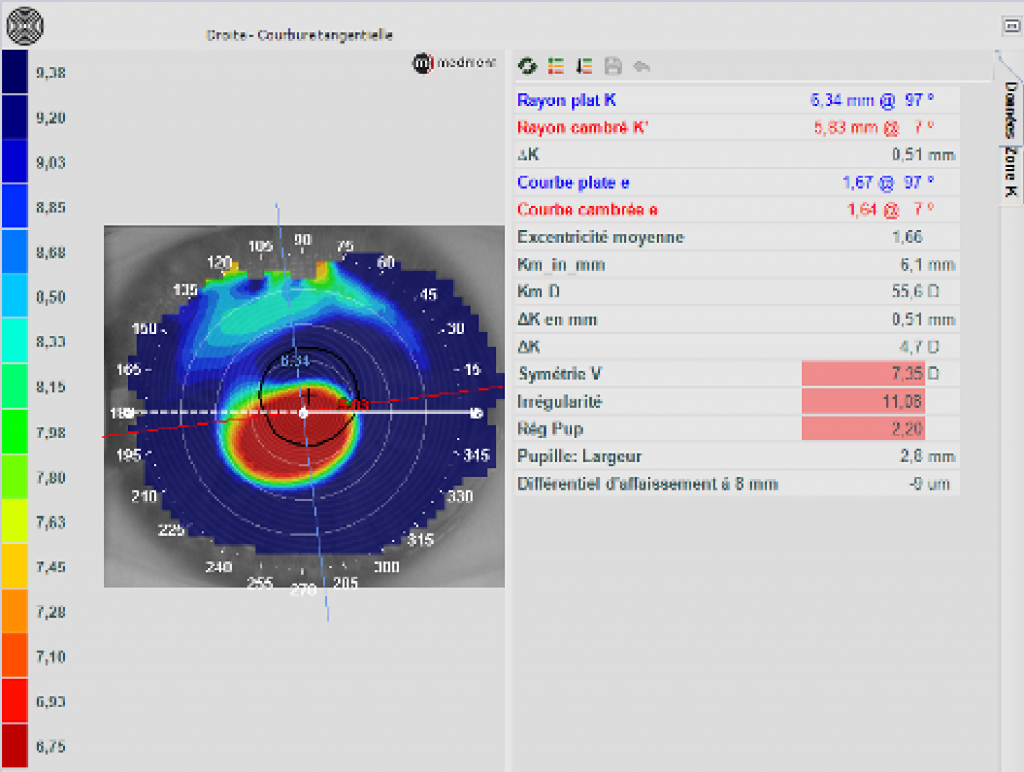
Typical appearance of a small, very pointed keratoconus with a strong peripheral flattening indicates a form of keratoconus that can be related to the Nipple Cone (NC) family.
Keratometry: 6.34/097*5.83 e=1.66
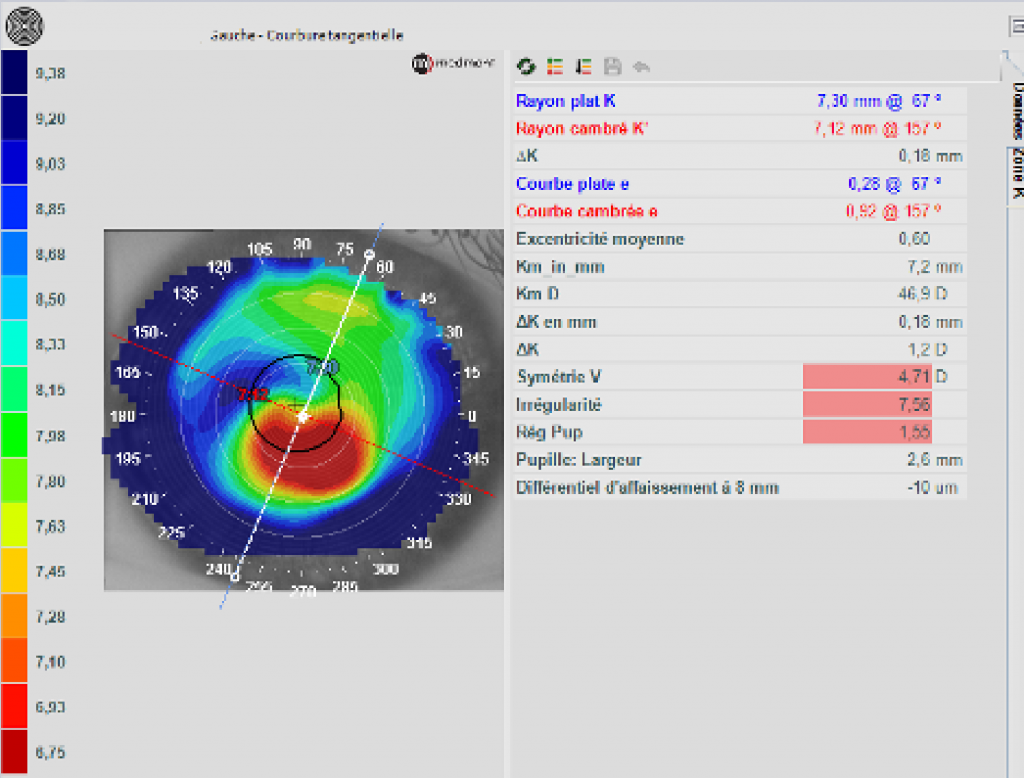
Here we see a typical form of this keratoconus. This side is less severe, with gentler flattening.
Keratometry: 7.30/067*7.12 e=0.60
Lens Fitting
Given the patient’s active lifestyle, we chose hybrid lenses in order to optimise the centration and stability of the lenses.
In order to meet the needs of this patient, we opted for a contact lens geometry with a design particularly suited to these two different stages of keratoconus, the AirKone geometry.
Comfort was improved through the addition of the Tangible Hydra-PEG treatment.
To give maximum flexibility in fitting options, the laboratory recommends carrying out the initial fitting assessment with a corneal GP lens design, noting the parameters, and then ordering that lens with the addition of the hybrid skirt. This means that the practice does not need to maintain duplicate fitting sets for GP keratoconus and hybrid keratoconus lenses, for example.
The initial fit was done with an AirKone corneal GP lens to assess the correct alignment using fluorescein. Following the fitting rules, r0=average K, we tried the following fitting set lenses:
AirKone: 6.10/8.70/-13.00 EL+1.0
Central fluorescein shows the lens is too flat by 0.1mm
Optimal peripheral fluorescein
Overcorrection: -1.25 20/20-
AirKone: 7.20/9.00/-3.00 EL 0.0
Central fluorescein shows the lens is aligned over the cone
Optimal peripheral fluorescein
Overcorrection: -2.75 20/20+
Based on the GP results, we followed the guidelines provided by the laboratory to order the EyeBrid AirKone lenses. In order to ensure good surface wettability, we specified the addition of the Tangible Hydra-PEG surface coating when ordering the lens.
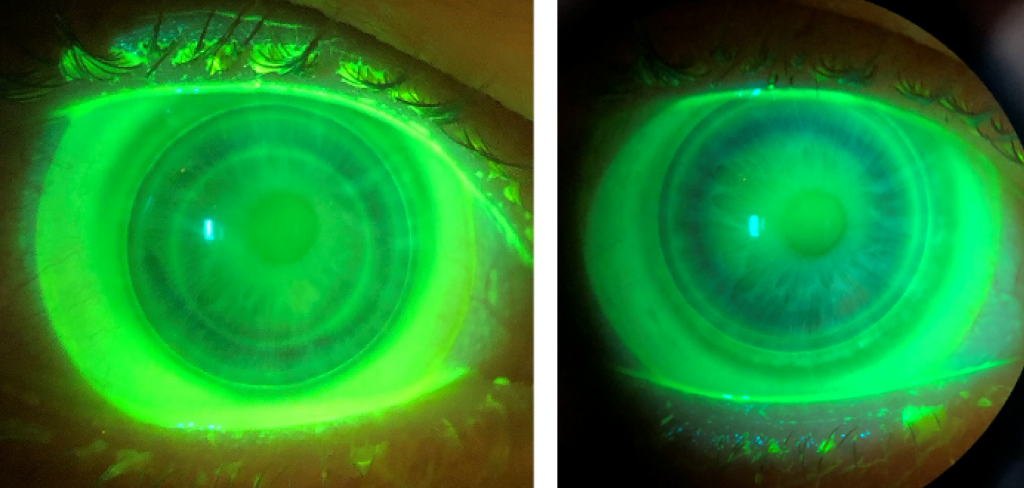
OD: EyeBrid AirKone 6.00 / 14.90 / -15.00. Edge lift +1.0 J(skirt) 0.0
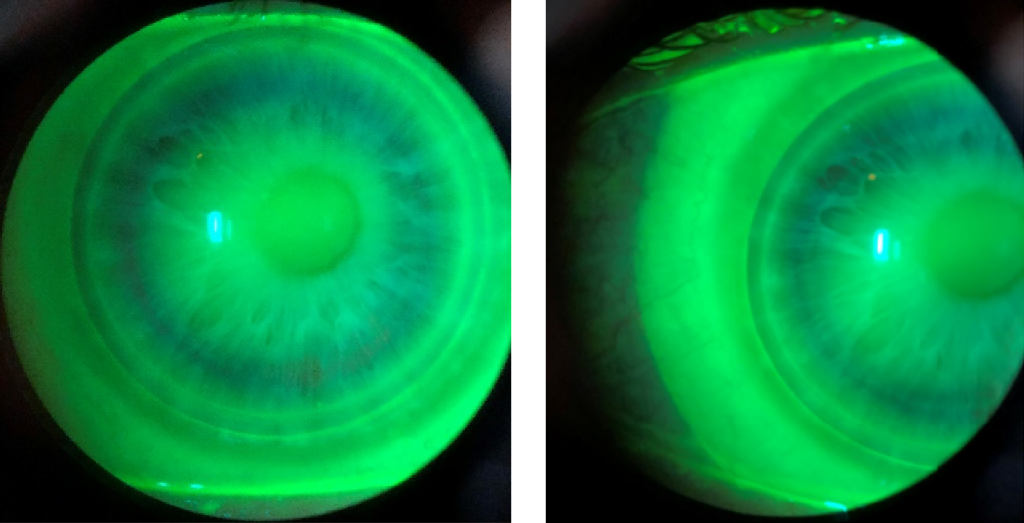
OS: EyeBrid AirKone 7.20 / 14.90 / -5.75. Edge lift 0.0 J(skirt) 0.0
The pictures show a good fit. BCVA rose to 20/20- OD and 20/20 OS. Surface wetting is good, and the patient reports good comfort. He wears his lenses for his professional and leisure activities for about 14 hours a day. He cares for his lenses with a hydrogen peroxide product and puts 2 drops of a hyaluronic acid-based comfort solution into each lens before putting them in his eyes. He puts his lenses in with a handling ring and removes them with a suction cup.
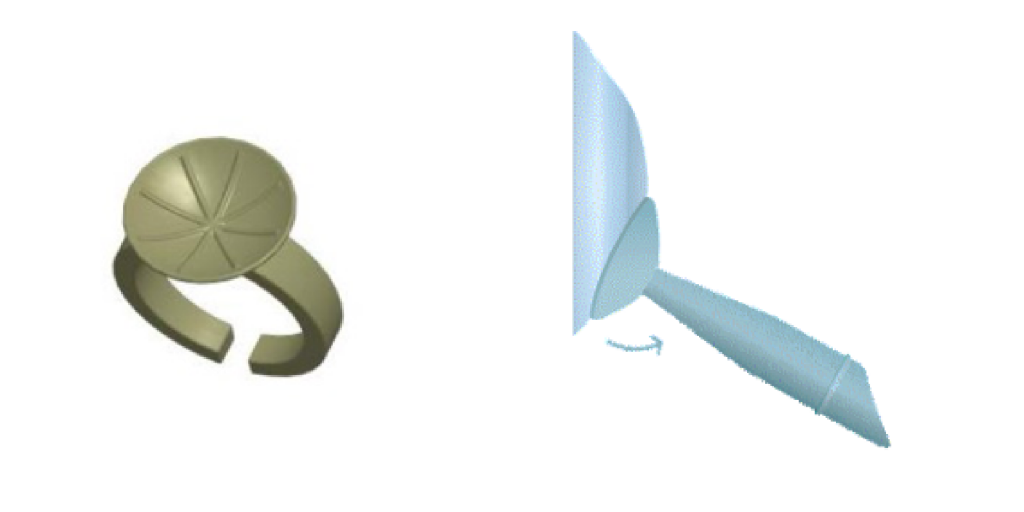
Patient Follow Up
After 3 weeks of wearing, the examination performed with the lenses on eye showed good stability, and slit lamp observations were unremarkable. We checked the integrity of the patient’s corneal epithelium after removing the Eyebrid lens: the corneas show no epithelial complications and no corneal staining.

Conclusion
Thanks to its excellent centration, stability, visual quality and comfort, the EyeBrid hybrid lens offers real solutions for both fitters and patients, regardless of the corneal morphology. Combined with a Tangible Hydra-PEG surface treatment, the lenses wet extremely well and are deposit-resistant while limiting friction with the eyelids. All these elements play in favour of improving patient comfort and allow the patient to continue wearing contact lenses.
Discussion
Although this patient was new to contact lenses, the same fitting philosophy can be applied to many existing, happy GP wearers using many different GP lens designs, who are getting older, whose tear film is changing, and who are experiencing reduced comfort levels. By keeping the same lens design, but simply adding a skirt, the patient can experience improved comfort levels.
Note: Eyebrid lenses have a GP centre manufactured from Optimum Extra (Dk 100), surrounded by a silicone hydrogel skirt manufactured in Definitive 50.
Thank you to Dimitri Guimond for contributing to Global Insight.

Dimitri is an optometrist and the director of Professional Services at LCS laboratory, contact lens manufacturer of hybrid, scleral, RGP, Ortho-K and soft lenses.
He has also taught at the University of Paris Orsay in optometry, and actively participates in the development of continuing education in contact lenses for ophthalmologists, orthoptists, optometrists and opticians. He regularly consults in private practice as well as in university hospital centres.


